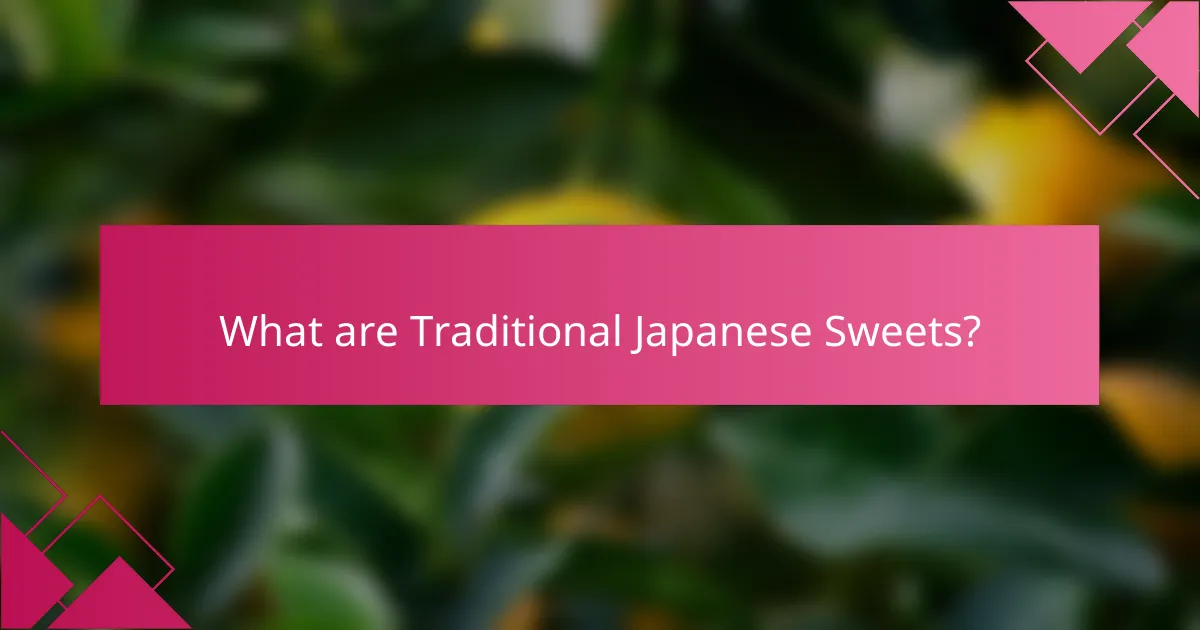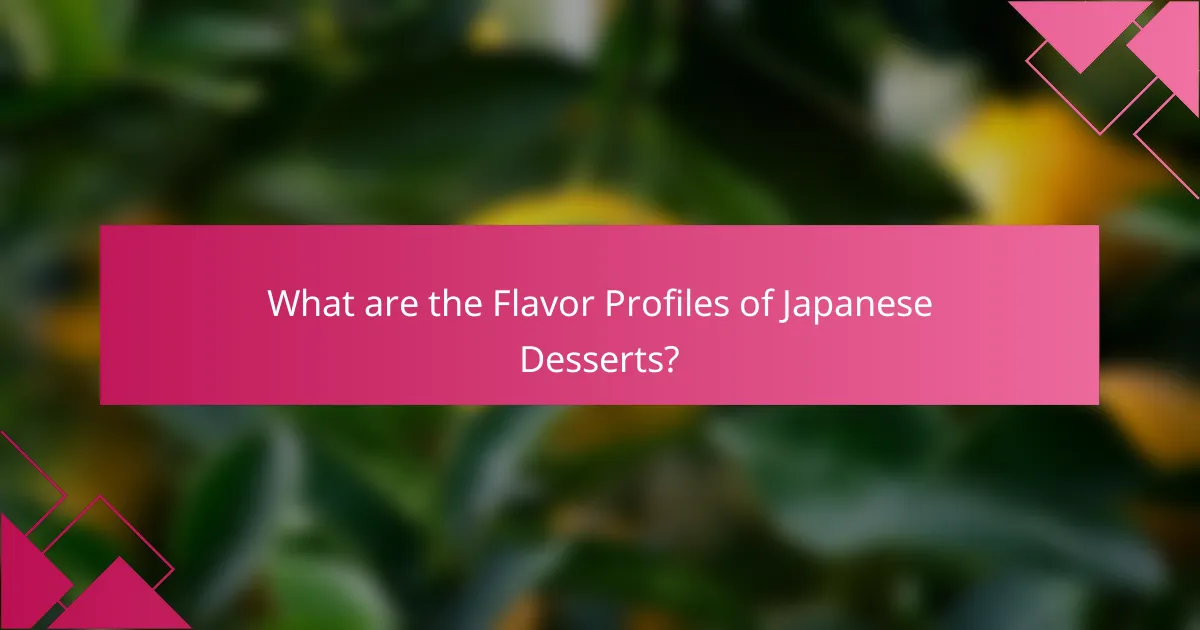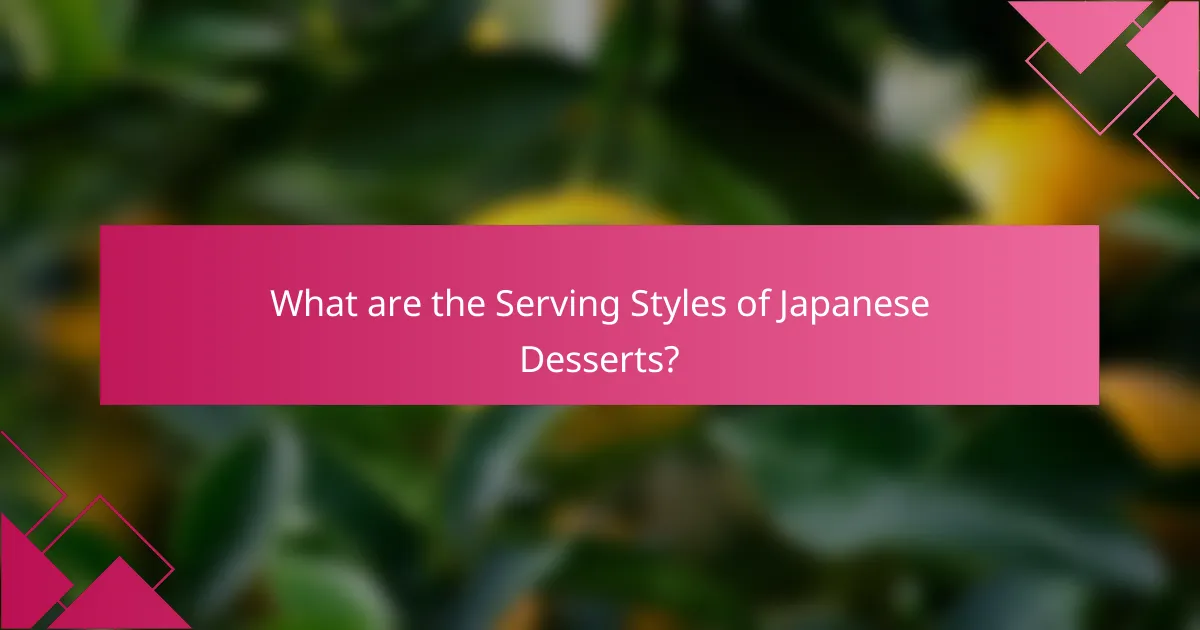
What are Traditional Japanese Sweets?
Traditional Japanese sweets, known as “wagashi,” are confections that reflect Japanese culture and aesthetics. They are typically made from natural ingredients such as rice flour, sweet bean paste, and fruits. Wagashi comes in various forms, including mochi, dorayaki, and anmitsu. These sweets are often enjoyed during tea ceremonies and seasonal festivals. The flavors are generally subtle and not overly sweet, emphasizing harmony with tea. Historical records indicate that wagashi has been enjoyed since the Heian period (794-1185). The preparation of these sweets is an art, with attention to shape, color, and presentation. Each type of wagashi often corresponds to a specific season or occasion, highlighting the connection between food and nature in Japanese culture.
How do Traditional Japanese Sweets differ from Western Desserts?
Traditional Japanese sweets differ from Western desserts primarily in their ingredients and flavor profiles. Japanese sweets often utilize rice, beans, and seasonal fruits. They typically emphasize subtle sweetness and umami flavors. In contrast, Western desserts frequently rely on sugar, cream, and chocolate. These desserts often feature bold, rich flavors and higher sweetness levels.
Moreover, traditional Japanese sweets are often served in smaller portions. They are designed to be enjoyed with tea, enhancing the overall experience. Western desserts, however, can be larger and are often served as standalone dishes. The presentation of Japanese sweets focuses on aesthetics and seasonal themes. This contrasts with the more varied styles of Western dessert presentation.
The historical context also plays a role. Japanese sweets have roots in tea ceremonies, reflecting cultural practices. Western desserts evolved from diverse culinary traditions, influenced by various regions and ingredients. This demonstrates a fundamental difference in cultural significance and culinary approach.
What ingredients are commonly used in Traditional Japanese Sweets?
Traditional Japanese sweets commonly use ingredients like rice flour, azuki beans, sugar, and matcha. Rice flour is essential for making mochi and dango. Azuki beans are often used in fillings for sweets like anko. Sugar is a key sweetener in various confections. Matcha adds a distinct flavor and color to many desserts. Other ingredients include agar-agar for jellies and fruits like yuzu for flavoring. These ingredients reflect the emphasis on natural flavors and textures in Japanese confectionery.
What are the most popular types of Traditional Japanese Sweets?
The most popular types of traditional Japanese sweets include mochi, dorayaki, and wagashi. Mochi is a glutinous rice cake often filled with sweet red bean paste. Dorayaki consists of two fluffy pancakes filled with sweet red bean paste or custard. Wagashi refers to a variety of traditional confections, often enjoyed with tea. These sweets are characterized by their delicate flavors and artful presentation. Mochi has a long history, dating back to ancient Japan. Dorayaki is popularized by the cartoon character Doraemon. Wagashi is often shaped to reflect seasonal themes and nature.
What cultural significance do Traditional Japanese Sweets hold?
Traditional Japanese sweets, known as wagashi, hold significant cultural importance in Japan. They are often associated with seasonal events and festivals. Each sweet reflects the aesthetics of nature, embodying the principles of harmony and balance. Wagashi are traditionally served during tea ceremonies, emphasizing the connection between food and social rituals. The preparation of these sweets involves meticulous craftsmanship, showcasing the artistry of Japanese culture. Ingredients often highlight local flavors and seasonal availability, reinforcing regional identities. Furthermore, wagashi serve as a medium for storytelling, often illustrating historical or literary themes. Overall, traditional Japanese sweets are a vital expression of cultural heritage and national identity.
How are Traditional Japanese Sweets connected to Japanese festivals?
Traditional Japanese sweets, known as wagashi, are deeply connected to Japanese festivals. These sweets are often made to celebrate seasonal events and cultural traditions. For example, sakura mochi is commonly enjoyed during Hanami, the cherry blossom viewing festival. Similarly, kashiwa mochi is eaten during the Children’s Day festival. Wagashi are not only treats but also symbolize the season and the festival’s significance. They are often beautifully crafted to reflect nature and seasonal themes. This connection enhances the festive atmosphere and provides a cultural experience. Festivals serve as occasions for sharing these sweets, fostering community and tradition.
What role do Traditional Japanese Sweets play in Japanese tea ceremonies?
Traditional Japanese sweets, known as wagashi, play a significant role in Japanese tea ceremonies. They serve to complement the flavors of matcha, enhancing the overall sensory experience. Wagashi are often crafted with seasonal ingredients, reflecting the time of year. This connection to nature adds depth to the ceremony’s aesthetic.
Additionally, sweets symbolize hospitality and respect towards guests. Their presentation is carefully considered, contributing to the visual appeal of the tea setting. The sweetness of wagashi balances the bitterness of matcha, creating a harmonious taste profile. This balance is essential for the overall enjoyment of the tea ceremony.
Historically, wagashi have been integral to tea culture since the 16th century. Their role has evolved, yet they remain a cherished element of the ritual today.

What are the Flavor Profiles of Japanese Desserts?
Japanese desserts feature a variety of flavor profiles, primarily characterized by sweetness, umami, and subtle bitterness. Common ingredients include azuki beans, mochi, and matcha. Sweetness often comes from sugar, honey, or sweetened red bean paste. Umami flavors are present in items like dango and some savory-sweet combinations. Subtle bitterness is typically found in matcha, which balances the overall sweetness. The use of seasonal ingredients also influences flavor, adding freshness. Traditional Japanese desserts often emphasize harmony and simplicity in taste, aligning with the aesthetics of Japanese culture.
How do flavor profiles in Japanese desserts vary by region?
Flavor profiles in Japanese desserts vary significantly by region. Each area incorporates local ingredients and traditions. For example, Hokkaido is known for its rich dairy products, leading to creamy desserts like soft serve ice cream. In contrast, the Kansai region favors sweet red bean paste, evident in treats like dorayaki. Kyushu is famous for its use of sweet potatoes, resulting in unique desserts such as imo yokan. The use of matcha is prevalent in Uji, known for its high-quality green tea. Additionally, Okinawa’s desserts often feature tropical fruits and brown sugar, creating distinct flavors. This regional diversity reflects Japan’s agricultural variations and cultural influences.
What are the common flavor profiles found in Traditional Japanese Sweets?
Traditional Japanese sweets typically feature subtle and delicate flavor profiles. Common flavors include matcha, which provides a rich, earthy taste. Red bean paste, known as ‘anko’, offers a sweet, creamy flavor. Sakura, or cherry blossom, imparts a floral note that is both refreshing and fragrant. Citrus flavors, such as yuzu, add a bright and tangy element. Additionally, chestnut is often used for its sweet and nutty flavor. These flavors reflect the seasonal ingredients and cultural significance in Japanese cuisine. Traditional sweets emphasize balance, with sweetness often being mild rather than overwhelming.
How do seasonal ingredients influence flavor profiles in Japanese desserts?
Seasonal ingredients significantly influence flavor profiles in Japanese desserts. The use of fresh, seasonal produce enhances the taste and authenticity of these sweets. For instance, sakura (cherry blossoms) in spring adds floral notes, while chestnuts in autumn provide a rich, earthy flavor. Each season brings unique ingredients that inspire specific desserts. This practice aligns with the Japanese philosophy of “shun,” which emphasizes consuming foods at their peak freshness. Seasonal variations also reflect local agricultural practices and cultural traditions. Therefore, the incorporation of seasonal ingredients is essential for creating diverse and harmonious flavor profiles in Japanese desserts.
What unique tastes can one expect from Japanese desserts?
Japanese desserts offer a unique blend of flavors that are often subtle and refined. Common tastes include sweetness balanced with umami. Ingredients like matcha provide a bitter note, enhancing complexity. Red bean paste adds a sweet, earthy flavor. Mochi contributes a chewy texture that complements various fillings. Seasonal fruits introduce freshness and acidity. Traditional sweets often feature rice, which adds a nutty undertone. Overall, Japanese desserts are characterized by harmony and balance in taste.
What are the differences between sweet and savory flavors in Japanese Sweets?
Sweet flavors in Japanese sweets are primarily derived from ingredients like sugar, honey, and sweetened red bean paste. These sweets, known as wagashi, are often enjoyed during tea ceremonies. Common examples include mochi, dorayaki, and anmitsu. Savory flavors, on the other hand, are found in snacks like senbei and onigiri. These items may incorporate ingredients such as soy sauce, seaweed, and sesame. The balance of flavors is essential in Japanese cuisine. Sweet flavors often provide a contrast to the umami and saltiness found in savory options. This variety enhances the overall tasting experience. The distinct preparation methods also differentiate these two categories. Sweet treats are usually delicate and visually appealing, while savory snacks focus on texture and flavor depth.
How do textures contribute to the overall flavor experience of Japanese desserts?
Textures play a crucial role in the flavor experience of Japanese desserts. They enhance the overall sensory enjoyment by providing contrast and complexity. For instance, the soft, chewy texture of mochi complements the sweetness of fillings like red bean paste. Similarly, the crispiness of a dorayaki pancake contrasts with its soft interior, creating a delightful mouthfeel.
Different textures can also influence the perception of sweetness. A creamy texture in desserts like matcha panna cotta can make flavors taste richer. In contrast, a light and airy texture in a soufflé cake can enhance the freshness of flavors.
Japanese desserts often incorporate multiple textures within a single dish. This layering of textures can elevate the eating experience, making it more engaging. For example, a dessert may combine smooth custard with crunchy toppings, creating a balance that excites the palate.
The interplay of textures and flavors in Japanese sweets is intentional. Chefs carefully design these elements to ensure a harmonious experience. This meticulous attention to texture is a hallmark of Japanese culinary tradition.

What are the Serving Styles of Japanese Desserts?
Japanese desserts are served in various styles that reflect cultural traditions. Common serving styles include individual portions, shared platters, and decorative presentations. Individual portions often feature items like mochi or daifuku, served in small bowls. Shared platters may contain an assortment of sweets, promoting communal enjoyment. Decorative presentations are prominent in kaiseki dining, where desserts are artfully arranged to enhance visual appeal. Seasonal themes often influence these styles, showcasing ingredients like sakura in spring. The serving style can also vary by occasion, such as festivals or tea ceremonies, emphasizing the cultural significance of each dessert.
How are Traditional Japanese Sweets typically presented?
Traditional Japanese sweets are typically presented with meticulous attention to aesthetics. They are often arranged on decorative plates or in elegant boxes. Seasonal themes are common in their presentation, reflecting nature’s beauty. Colorful and intricate designs enhance their visual appeal. The use of natural materials, like bamboo or wood, is frequent in serving dishes. These sweets are usually accompanied by green tea, which complements their flavors. Presentation aims to create a harmonious experience for the senses. This practice aligns with the Japanese philosophy of beauty and simplicity in food.
What are the common serving styles for Japanese desserts during celebrations?
Common serving styles for Japanese desserts during celebrations include individual servings and communal sharing. Individual servings are often presented in small, decorative dishes. This style enhances the aesthetic appeal and allows guests to enjoy their own portion. Communal sharing involves placing desserts on a central platter for guests to serve themselves. This fosters a sense of togetherness and encourages social interaction. Seasonal themes play a significant role in presentation, with decorations reflecting the time of year. For example, cherry blossoms are common in spring celebrations. Traditional serving styles emphasize simplicity and elegance, aligning with Japanese cultural values. These practices enhance the overall celebratory experience.
How does the presentation of Japanese desserts enhance the dining experience?
The presentation of Japanese desserts significantly enhances the dining experience by appealing to the senses and creating a visual feast. Japanese desserts often feature intricate designs and vibrant colors. This aesthetic quality invites diners to appreciate the craftsmanship involved. The use of seasonal ingredients is also reflected in the presentation, connecting the dessert to nature. For example, sakura-themed sweets showcase cherry blossoms during spring. Additionally, the arrangement of desserts on plates emphasizes balance and harmony, fundamental principles in Japanese culture. Such thoughtful presentation elevates the overall enjoyment of the meal. It engages diners emotionally and culturally, making the experience memorable.
What are the best practices for enjoying Japanese desserts?
To enjoy Japanese desserts, start by appreciating their presentation. Japanese sweets, known as wagashi, are often crafted to be visually stunning. Take time to observe the colors and shapes before tasting. Next, consider pairing desserts with appropriate teas, such as matcha or hojicha. This enhances the flavor experience and complements the sweetness.
Savor each bite slowly to fully appreciate the textures and flavors. Many Japanese desserts feature unique ingredients like red bean paste or mochi. Familiarize yourself with these components for a deeper understanding. Additionally, enjoy desserts in a calm environment to enhance the overall experience.
Eating with mindfulness can elevate your enjoyment. Lastly, try a variety of desserts to discover personal preferences. Each type, from dorayaki to daifuku, offers distinct tastes and textures. Exploring different options can lead to new favorites.
How should one pair Traditional Japanese Sweets with beverages?
Pair Traditional Japanese sweets with beverages by considering flavor harmony. Match the sweetness of the dessert with the beverage’s taste profile. For example, match matcha with sweet red bean paste. The bitterness of matcha balances the sweetness. Pair mochi with green tea for a refreshing contrast. The chewy texture of mochi complements the smoothness of the tea. Additionally, serve dorayaki with hojicha for a roasted flavor experience. The warm notes of hojicha enhance the sweetness of the pancake. Traditional pairings often enhance the overall tasting experience. This approach reflects Japanese culinary principles of balance and harmony.
What tips can enhance the appreciation of flavors in Japanese desserts?
To enhance the appreciation of flavors in Japanese desserts, focus on the balance of sweetness and umami. Japanese desserts often incorporate ingredients like matcha, adzuki beans, and mochi. Pairing these ingredients with contrasting textures can elevate the experience. For example, combining soft mochi with crunchy toppings adds depth.
Serving desserts at the right temperature is crucial. Cold desserts can highlight sweetness, while warm desserts can enhance flavors. Mindful tasting is also important. Take small bites and savor each flavor.
Presentation plays a significant role in flavor perception. Beautifully arranged desserts can stimulate visual senses, enhancing overall enjoyment. Lastly, understanding the cultural context of each dessert can deepen appreciation. For instance, knowing the significance of seasonal ingredients can enrich the tasting experience.
The article focuses on traditional Japanese sweets, known as wagashi, which are integral to Japanese culture and often made from natural ingredients like rice flour and sweet bean paste. It explores the various types of wagashi, such as mochi and dorayaki, and their unique flavor profiles that emphasize subtle sweetness and umami. Additionally, the article examines the cultural significance of these sweets in relation to Japanese festivals and tea ceremonies, highlighting their artistic presentation and the importance of seasonal ingredients. Finally, it discusses serving styles and best practices for enjoying these desserts, including appropriate beverage pairings to enhance the overall flavor experience.
